White elephant – definition and meaning
A white elephant is something that cost a lot of money to create and is very expensive to maintain – it is totally unprofitable and is likely to remain so. The term ‘white elephant’ may refer to: 1. Something unprofitable that cost a lot to create. 2. Something unprofitable that is expensive to maintain. 3. A combination of both numbers 1 and 2.
If a business becomes a white elephant, it means that it cannot turn a profit because it is too expensive to operate and maintain.
In the world of business and finance, nobody wants to purchase or own a business, or anything for that matter, that is considered to be a white elephant.
The Financial Times’ glossary of terms, ft.com/lexicon, has the following definition for ‘white elephant’:
“Something that is completely useless, even though it cost a lot of money.”
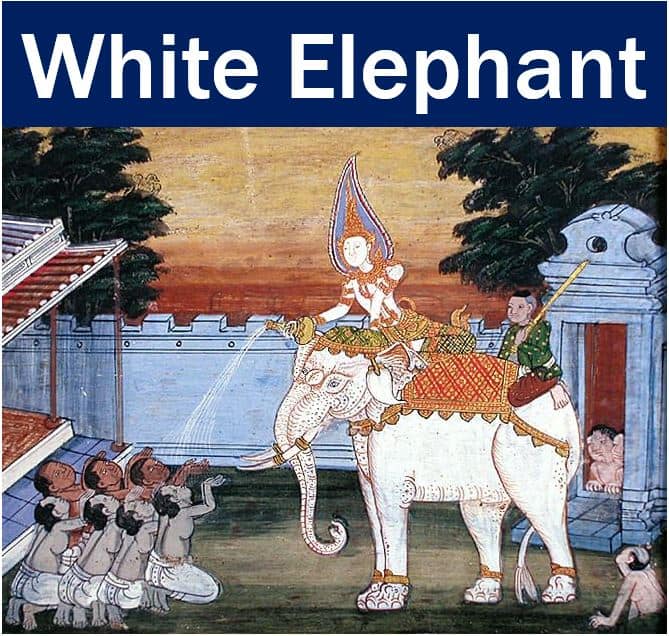 A white elephant (albino elephant) was given by the King of Siam to a subordinate that he did not like. The elephant needed a special diet, it was extremely costly to keep, and did not work – people worshiped it. Looking after one could financially that subordinate! (Image: Wikipedia)
A white elephant (albino elephant) was given by the King of Siam to a subordinate that he did not like. The elephant needed a special diet, it was extremely costly to keep, and did not work – people worshiped it. Looking after one could financially that subordinate! (Image: Wikipedia)
White elephant – origin of the term
In ancient times in Siam (called Thailand since 1949) and some other Asian nations, albino elephants were regarded as holy. Albino elephants are completely white.
Keeping an albino elephant – a white elephant – was extremely expensive; it required a special diet, could not work, and everybody wanted to worship it.
When the King of Siam disliked one of his subordinates, he would burden him or her with a white elephant. In many cases, the gift would ruin the recipient.
The term ‘white elephant’ in the West, relating to something that is expensive, unprofitable, and fails to meet expectations, dates back to the 1600s, and became a common expression by the 1800s.
Today, in the English language, the term is commonly used by politicians in opposition (those not in power) to criticize ambitious and controversial architectural ‘grand projects’ which many fear will cost a great deal of money and bring disappointing benefits.
Many of the construction projects undertaken by cities and countries that have hosted grand sporting events, such as the Olympics or the FIFA World Cup, have been criticized by politicians, newspapers and the local populations for creating white elephants.
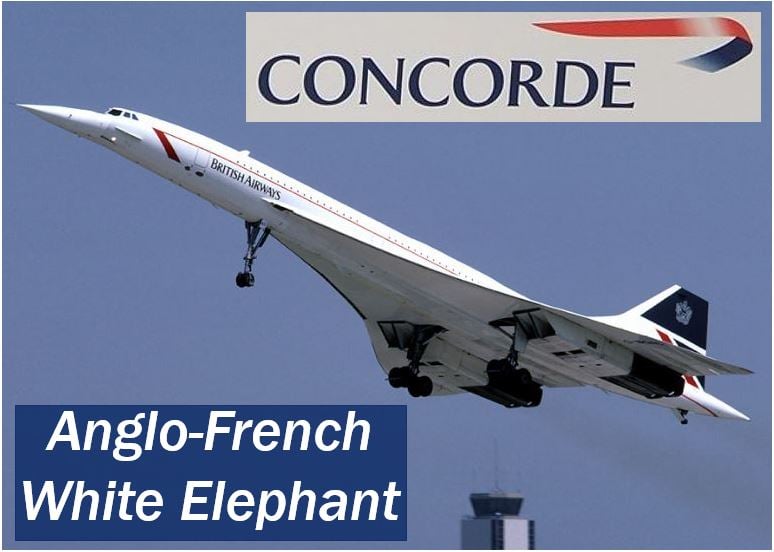 As far as British and French taxpayers were concerned, Concorde was a costly white elephant. (Image: adapted from Wikipedia)
As far as British and French taxpayers were concerned, Concorde was a costly white elephant. (Image: adapted from Wikipedia)
White elephant – Concorde
In the Summer of 1964, British Prime Minister Alec Douglas-Hume received a memo from a Cabinet Office civil servant informing him that the Anglo-French project to develop the Concorde supersonic passenger aircraft was spiraling out of control. This was five years before the aircraft’s maiden flight.
According to the civil servant, the project was set to cost more than two Channel Tunnels. “There were always doubts about this project,” the civil servant wrote.
The UK’s state airline BOAC, which had previously been saddled with an unprofitable aircraft, did not want another one, the memo added.
The civil servant conceded that although the Anglo-French entente made it difficult to abandon the project completely, he insisted that a “complete commitment should be avoided for the time being.”
In a BBC News Online article, published in October 2003, Business Reporter James Arnold wrote that it was a pity that nobody listened.
Mr. Arnold wrote:
“Concorde has always appealed far more to politicians and engineers than to administrators and economists. As late as 1971, when the aircraft was to all intents and purposes a fait accompli, Concorde was being called ‘a commercial disaster’, which ‘should never have been started.'”
“But the same paper conceded that political considerations gave London no choice but to ‘commit itself whole-heartedly and publicly to Concorde.'”
In 1962, Concorde was projected to cost approximately £160 million, which is about £2 billion ($2.6 billion) in today’s money. By 1975, one year before the aircraft’s commercial launch, at least £11 billion in today’s money had been spent.
Apart from a few rock stars and ultra-patriotic well off Britons, the majority of first-class passengers were put off by the cramped conditions and exorbitant prices.
At the time, you could fly first class across the Atlantic and back for £3,000 on a Jumbo Jet, while a Concorde ticket would set you back at least £8,000.
As far as British and French economists are concerned, Concorde was a giant white elephant. Not one aircraft was ever commercially sold!
Famous white elephants
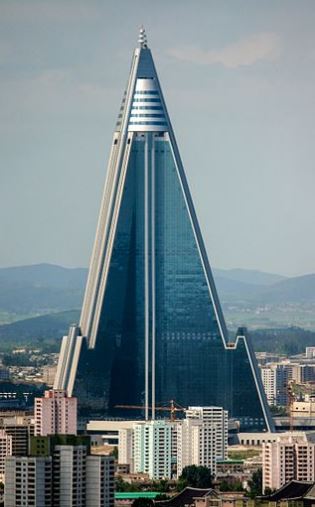 For North Korea – one of the world’s poorest countries that is barely able to feed its population – the Ryugyong Hotel project is a white elephant beggars belief. (Image: Wikipedia)
For North Korea – one of the world’s poorest countries that is barely able to feed its population – the Ryugyong Hotel project is a white elephant beggars belief. (Image: Wikipedia)
– Ryugyong Hotel: in Pyongyang, North Korea. It is a 105-floor unfinished skyscraper. Construction began in 1987. It has been planned as a mixed-use development, which will include a luxury hotel. The building boasts 3,000 rooms, which is approximately the total number of western tourists that visit North Korea each year. Several inauguration dates have been announced over the past twenty years – all of them have been cancelled.
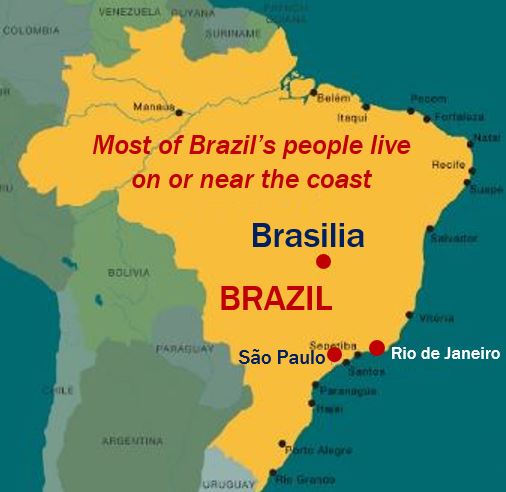 Why build a new capital city many hundreds of miles from where all the businesses and main population centers of the country are? It was an expensive project, which subsequently made it more expensive for embassies and consulates to do their work, and for businesses to liaise with government departments. (Image: adapted from imgion.com)
Why build a new capital city many hundreds of miles from where all the businesses and main population centers of the country are? It was an expensive project, which subsequently made it more expensive for embassies and consulates to do their work, and for businesses to liaise with government departments. (Image: adapted from imgion.com)
– Brasilia: this is an example of a whole city white elephant. The city was built in the interior of Brazil, the aim being to help develop that part of the country. The problem is that all the embassies, government buildings, agencies, etc. are located hundreds of miles from the country’s main centers of industry and population.
At weekends, those who can afford it vote with their feet and head for Rio de Janeiro or São Paulo.
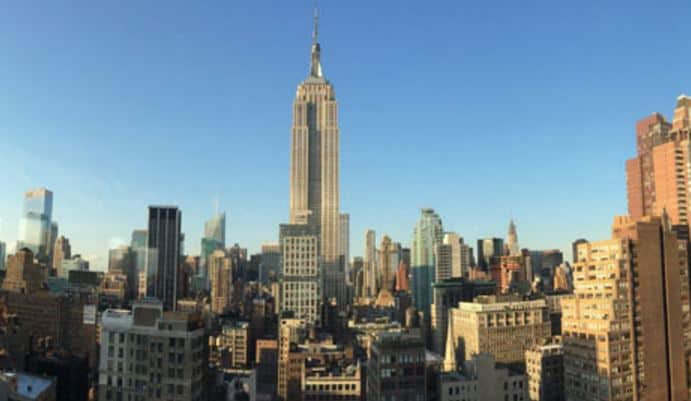 The Empire State Building is the fourth-tallest building in the United States. Its name is derived from the nickname for New York – the Empire State. (Image: newyorkpass.com)
The Empire State Building is the fourth-tallest building in the United States. Its name is derived from the nickname for New York – the Empire State. (Image: newyorkpass.com)
– Empire State Building: who would believe that an icon of New York could be a white elephant! The building was planned during the 1920s, and was completed when the Great Depression was in full swing.
When it opened, only one fifth of the Empire State Building was occupied. In fact, it was not until 1950 that it started to break even. Even today, approximately thirty-percent of the building remains empty.
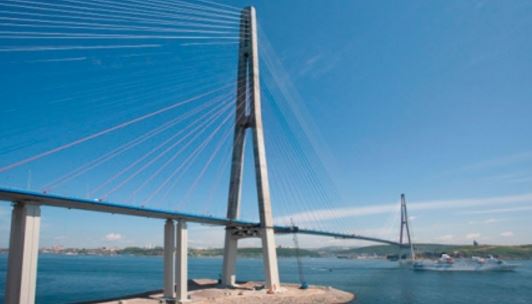 According to roadtraffic-technology.com: “The 1,885m (3,887ft) Russky Island Bridge in Russia, inaugurated in July 2012, connects Russky Island with the city of Vladivostok. It is the longest cable-stayed suspension bridge in the world and reaches 70m above water level. The bridge crosses the Eastern Bosphorus Strait, linking with the mainland and island, home to around 5,000 inhabitants.” (Image: roadtraffic-technology.com)
According to roadtraffic-technology.com: “The 1,885m (3,887ft) Russky Island Bridge in Russia, inaugurated in July 2012, connects Russky Island with the city of Vladivostok. It is the longest cable-stayed suspension bridge in the world and reaches 70m above water level. The bridge crosses the Eastern Bosphorus Strait, linking with the mainland and island, home to around 5,000 inhabitants.” (Image: roadtraffic-technology.com)
– Russky Bridge: in Eastern Russia, not far from the borders with North Korea and China, across the sea from Japan, is the city of Vladivostok. The city is the home port of the Russian Pacific Fleet. In 2007, the city was chosen as the site for the 2012 Asia Pacific Economic Conference.
Vladimir Putin ordered the construction of a $1 billion cable bridge to connect mainland Vladivostok to Russky Island, where the conference was to be held.
The bridge, which would rival the Golden Gate Bridge in San Francisco, would show the world what Russia was capable of, Putin thought.
What Putin did not bear in mind, however, was that the Golden Gate Bridge, like any other bridge across the world, connects major population centers. Russky Island, with just 5,000 residents, is not what one would call a major population center. The bridge was built to handle more than fifty thousand cars each day.
As far as the conference delegates and reporters were concerned, the bridge was great – it made it extremely easy and convenient to get to the island from the mainland. However, after the conference had ended, traffic vanished nearly completely. Russian authorities are hoping to turn the island into a tourist attraction – an idea that has not yet materialized.
Video – White Elephant: Top Ten
This Top Tenz video looks at the top ten white elephant construction projects – projects that were huge wastes of time and money.

